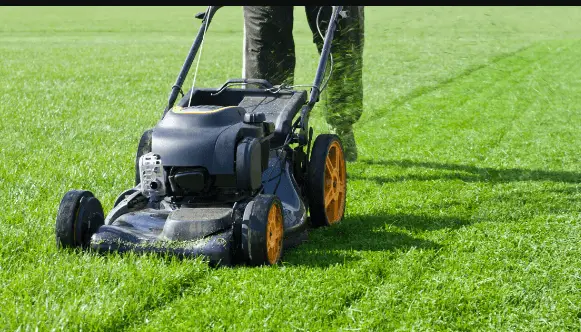If you’re having trouble pushing your riding lawn mower in neutral, it’s important to first determine the cause of the issue.
There are a few potential causes, and identifying the root of the problem will help you troubleshoot and fix the issue.
Let’s dive in.

Can’t Push Riding Mower in Neutral
Causes of Riding Lawnmower Won’t Move in Neutral
1. Damaged or Broken Drive belt
One potential cause of this problem is a damaged or broken drive belt. The drive belt is responsible for transferring power from the engine to the wheels, so if it’s damaged or broken, the mower may not move even when it’s in neutral.
To check for a damaged drive belt, locate the belt cover on the side of the mower and remove it.
Inspect the belt for any signs of wear or damage, such as fraying, cracks, or missing chunks. If the belt is damaged, it will need to be replaced.
2. Broken Drive Pulley
Another potential cause of difficulty pushing the mower in neutral is a damaged or broken drive pulley.
The drive pulley is located on the underside of the mower and is responsible for turning the drive belt.
If the pulley is damaged or broken, it may be causing the mower to be difficult to push.
To check for a damaged drive pulley, locate the pulley and inspect it for any signs of wear or damage.
If the pulley is damaged, it will need to be replaced.
Read Can you Pulley swap a Hydrostatic Mower? (Explained)
3. Malfunctioning Transmission
A third potential cause of difficulty pushing the mower in neutral is a malfunctioning transmission.
The transmission is responsible for transferring power from the engine to the wheels, and if it’s not functioning properly, the mower may be difficult to push.
To determine if the transmission is the cause of the issue, check the transmission fluid level. If the fluid level is low, add more fluid to the transmission.
If the fluid level is fine, the transmission may need to be repaired or replaced.
Read Will a Bad PTO Clutch Cause Power Loss?(Explained)
4. Damaged or Broken Drive Chain
Finally, another potential cause of difficulty pushing the mower in neutral is a damaged or broken drive chain.
The drive chain is responsible for transferring power from the engine to the wheels, and if it’s damaged or broken, the mower may be difficult to push.
To check for a damaged drive chain, locate the chain cover on the underside of the mower and remove it.
Inspect the chain for any signs of wear or damage, such as broken links or stretched chains. If the chain is damaged, it will need to be replaced.
Read How to Put a Troy-Bilt Lawn Mower in Neutral(In 3 Steps)
How to Fix Mower is stuck in neutral gear
| Possible cause of the problem | Troubleshooting steps |
| Damaged or broken drive belt | Locate the belt cover on side of the mower and remove it. Inspect the belt for any signs of wear or damage, such as fraying, cracks, or missing chunks. If the belt is damaged, replace it. |
| Damaged or broken drive pulley | Locate the drive pulley on the underside of the mower and inspect it for any signs of wear or damage. If the pulley is damaged, replace it. |
| Malfunctioning transmission | Check transmission fluid level. If the fluid level is low, add more fluid to the transmission. If the fluid level is fine, the transmission may need to be repaired or replaced. |
| Damaged or broken drive chain | Locate the chain cover on the underside of the mower and remove it. Inspect the chain for any signs of wear or damage, such as broken links or stretched chains. If the chain is damaged, replace it. |
Read How to Bypass Safety Switch on Zero Turn(In 3 Easy Steps)
How to Put Riding Mower in Neutral
- Ensure the mower is parked on a level surface and the engine is turned off.
- Locate the parking brake lever or pedal. It is usually located on the left side of the mower, near the driver’s seat.
- Disengage the parking brake by either releasing the lever or pushing down on the pedal, depending on your mower’s design. Make sure the parking brake is fully disengaged.
- Look for the transmission controls. They are typically located near the driver’s seat or on the dashboard.
- Engage the clutch or release the transmission lever, depending on the type of transmission your mower has. This action should disengage the transmission from the engine.
- Gradually attempt to push the mower forward or backward to check if it is in neutral. Apply gentle pressure to avoid sudden movements.
Read Lawn Mower Makes Grinding Noise When Trying to Start(Solved)
Hydrostatic Transmission Won’t Disengage
- Check the controls. Ensure that the controls, such as the levers or pedals, are in the neutral position or released completely. Sometimes, a partially engaged control can prevent the transmission from disengaging.
- Check the linkage: Inspect the linkage connecting the controls to the hydrostatic transmission. Look for any loose or disconnected parts that may be interfering with the disengagement.
- Check the fluid level. Hydrostatic transmissions rely on hydraulic fluid to operate effectively. Inspect the fluid level in the transmission reservoir. If it is low, add the recommended fluid as specified in the manufacturer’s instructions. Low fluid levels can cause issues with disengagement.
- Inspect the drive belt. A worn or damaged drive belt can prevent the hydrostatic transmission from disengaging. Examine the drive belt for signs of wear, fraying, or slipping.
- Check for debris or obstructions: Debris, such as grass clippings or dirt, can accumulate around the linkage or control mechanisms, hindering the disengagement process. Clean the area around the transmission and controls, removing any obstructions that may be affecting their operation.
Final Remark
If you’re having difficulty pushing your riding lawn mower in neutral, there are a few potential causes to consider.
These include a damaged or broken drive belt, drive pulley, transmission, or drive chain.
To troubleshoot the issue, check for any signs of damage or wear on these components, and replace or repair them as necessary.
With a little bit of patience and some basic knowledge of how your mower works, you should be able to fix the problem and get your mower running smoothly again.
Read Will a Lawn Mower run with a Dead Battery(What To do)
FAQ
Why am I unable to push my riding mower when it is in neutral?
There could be a few reasons why you can’t push your riding mower into neutral. Let’s explore some common causes and potential solutions.
What does it mean when a riding mower is in “neutral”?
When a riding mower is in neutral, it should be disengaged from the engine, allowing you to push it manually without the engine running.
What should I check if I can’t push my riding mower into neutral?
Here are a few things to check if you’re unable to push your riding mower into neutral:
- Parking brake: Ensure that the parking brake is disengaged. Some riding mowers have a separate lever or pedal to engage and disengage the parking brake.
- Transmission: Check if the transmission is in neutral. Refer to your mower’s manual to locate the specific controls for engaging and disengaging the transmission. Make sure it is properly set to neutral.
- Hydrostatic transmission: If your riding mower has a hydrostatic transmission, there might be a release lever or bypass valve. Consult your manual to find the location of the release lever or valve and ensure it is in the correct position for pushing.
- Belt tension: Inspect the drive belt that connects the engine to the transmission. If the belt is loose or damaged, it may prevent the mower from being pushed into neutral. Adjust or replace the belt if necessary.
- Mechanical issues: If none of the above solutions resolve the problem, there might be mechanical issues with the mower’s transmission or drivetrain. In such cases, it’s best to consult a professional technician or contact the manufacturer for assistance.
why won’t my riding lawn mower roll in neutral
If you’ve gone through all the potential causes mentioned above and are still unable to push your riding mower into neutral,
it’s recommended that you seek help from a professional technician who specializes in small engine repair.
They will have the necessary expertise to diagnose and fix any mechanical issues that might be preventing the mower from being pushed into neutral.
Is it safe to force the riding mower to move when it’s in neutral?
It is not advisable to force the riding mower to move if it is not intended to be pushed into neutral. Doing so may cause damage to the mower’s transmission or other components.
It’s best to identify and resolve the underlying issue causing the problem or seek professional assistance.
Read 11 Common Gravely Mower Electrical Problems(With Solutions)




